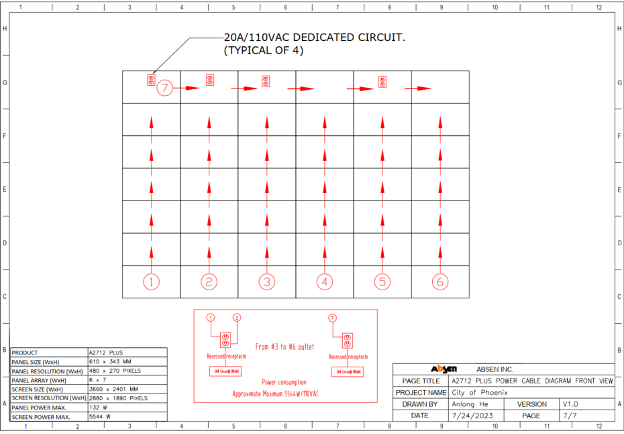How LG’s Transparent LED Film is Revolutionizing Display Technology
In this blog, we’ll explore the technology behind LG’s Transparent LED, its potential applications, and how it’s poised to change the way we think about large glass spaces and how they can be used for messaging in a unique way.
What is Transparent LED?
 At its core, LG’s Transparent LED is a cutting-edge display technology that uses micro thin nano wires laminated between transparent silicon-based film, allowing light to pass through. This enables the display to offer high-quality visuals without completely obstructing the view behind it. The current LTAK140-GU1 product has a 13.7mm pixel pitch with 60% transparency and features 1,000 nits of brightness. It is sold in sheets of a self-adhesive film that are “squeegeed” onto glass. The sheets are 25.8” x 19.4” and can accommodate convex/concave surfaces. The material can be cut vertically between rows of “pixels” to accommodate almost any size space. Rails are installed vertically or horizontally, and ribbon cables attach to the rails. Each rail connects to the controller that transmits data and content. The unit controller distributes the signal to the rails, manages content, and the layout of the wall. Applicable parts are are the LCLG141U and LCLG002.
At its core, LG’s Transparent LED is a cutting-edge display technology that uses micro thin nano wires laminated between transparent silicon-based film, allowing light to pass through. This enables the display to offer high-quality visuals without completely obstructing the view behind it. The current LTAK140-GU1 product has a 13.7mm pixel pitch with 60% transparency and features 1,000 nits of brightness. It is sold in sheets of a self-adhesive film that are “squeegeed” onto glass. The sheets are 25.8” x 19.4” and can accommodate convex/concave surfaces. The material can be cut vertically between rows of “pixels” to accommodate almost any size space. Rails are installed vertically or horizontally, and ribbon cables attach to the rails. Each rail connects to the controller that transmits data and content. The unit controller distributes the signal to the rails, manages content, and the layout of the wall. Applicable parts are are the LCLG141U and LCLG002.
Unlike traditional LED displays that require a solid background or opaque surface, Transparent LED maintains a high level of transparency, making it suitable for those large spaces with plenty of glass. Recently, a convention center inquired about the product as they have four floors with escalators where glass railings are in full view. The space also had four-story high windows above the entrances where signage could be applied. Using the LED product, they would not lose glass transparency when LED was not in use, and content could be easily customized for directional and way-finding information specific to events as people entered the building. For this customer to proceed and budget for a potential installation, they needed to balance the income that could be generated from offering customers the option to display on the LED space. Content would be most noticeable entering the convention center. Would the additional revenue stream justify the initial investment? The other advantage would be the Convention Center adopting leading-edge technology and stepping “outside-the-box” from traditional static or smaller size signage displays.
Besides convention centers, we receive a lot of inquiries about Transparent LED, especially after LG outfits their booths with this product at shows such as CES and InfoComm. There is a lot of interest for transparent displays for C-store windows, restaurants, and airports. Keep in mind that the LTAK runs about $650 per square foot, not including content mapping or installation.
Content
Designing, configuring, and installing LTAK LED takes some planning and work with the LG system design engineers. Another key aspect of this product is content. Traditional 2K/4K 16:9 content is not ideal for this product. Up close, the LTAK looks very pixelated, and adding content that is stretched does not help. For optimal output, content will need to be purposed in the resolution of the designed LED wall, keeping in mind the optimal viewing distance of 70 feet.
For reference, the images and video rendering in this blog post were provided by LG as examples of content usage.

Some considerations for your customer might be:
- What is the value proposition of replacing smaller traditional signage over the course of five years? Would being able to update messaging remotely and without on-site labor be a cost savings?
- Is your customer wanting to explore new and different ways of messaging than what is traditional? Are they looking for the “wow” factor that changes an ordinary space to an immersive experience? Are they looking to step outside the box of tradition and market in a new way?
- Would a transparent solution allow for content that excites and draws people to a place or product that would enhance a revenue stream?
- How can the costs of a transparent LED solution be offset with potential new product offerings or venues?
For regulatory concerns on light and heat passing through the glass, bear in mind that LG’s LTAK accommodates up to 32°F ~ 113°F. It is recommended to check with local and state agencies for Green Performance Standards and outward-facing ordinances for signage. We are always happy to help with information and quotes for Transparent LED.

Applications of LG Transparent LED
Retail and Advertising
In the retail industry, the transparent nature of the display can be used to create striking visual displays without sacrificing the view of the products behind the screen. Imagine a store window where a vibrant ad plays on a transparent screen, but customers can still see the merchandise clearly. This creates a dynamic and engaging shopping experience while allowing the store to display information, promotions, or brand storytelling in a more interactive and immersive way.
Corporate Environments and Lobbies
Corporate spaces, conference rooms, and lobbies can also benefit from LG’s Transparent LED. These installations can be used to display important information, brand messaging, or media content, all while preserving the open feel of the space. The transparency feature is especially useful in large, open spaces where you want to maintain visibility and aesthetics without sacrificing the functionality of a display.
Transportation Hubs
Airports, train stations, and subway systems are some of the most bustling environments where clear, real-time information is critical. LG’s Transparent LED could be used in these spaces for dynamic signage and wayfinding. The transparency allows passengers to see through the display, ensuring that the area remains visually open, while the screen serves its purpose of providing essential information.
Smart Buildings and Windows
One of the most exciting potential applications is the use of transparent displays as smart windows in homes and offices. Imagine looking out of your window and being able to view dynamic content—news, weather, or interactive media—without any interruption to the natural light or view. This concept could transform the way we design buildings and homes, creating intelligent, multi-functional spaces that adapt to our needs.
Museum and Art Installations
In cultural and art institutions, Transparent LED can bring art to life in new ways. By integrating the transparent display technology into exhibits, museums can offer layered experiences where the display enhances the artwork without detracting from the overall aesthetic. It allows curators to tell more compelling stories with mixed media, projections, and digital elements.
Automotive Industry
The automotive industry is also exploring the use of transparent displays in cars. LG’s Transparent LED can be used to create interactive dashboards, heads-up displays, or even entire windshields.
Conclusion
LG’s Transparent LED represents a leap forward in display technology, offering unparalleled versatility and wow factor. As businesses and industries continue to look for innovative ways to communicate and engage with audiences, transparent LED technology will undoubtedly play a crucial role in shaping the next generation of visual communication.
Whether you’re in retail, transportation, or design, this technology has the power to elevate your space while maintaining an open, engaging, and interactive environment. Welcome to the transparent revolution!
If you would like to learn more about LG’s Transparent LED or our extensive line of DVLED products, including indoor, outdoor, marine grade, simple-to-install All-in-One, or the incredible Magnit 4K series in .7mm and .9mm, please give us a call as we are always happy to assist.
Interested in outdoor AV? Try Jennifer’s other blog, “Maximizing Visibility, Outdoor Signage at It’s Brightest“

About the Author
Jennifer Fisher
BDM – Brand Specialist
Supported Manufacturers: LG Business Solutions (SW, W, NW)




 All-in-one DVLED displays are a great option as they do not require external LED controllers/sender units to operate since all the required components are built into the unit, so it functions like a standard monitor, and there are typically several predefined sizes to work in various environments. The other option for DVLED is a custom video wall solution. Custom DVLED walls are a good option when you have an application requiring a specific size display, atypical aspect ratio, or need specific resolutions or brightness levels. Custom DVLED allows the user the broadest choice in selecting products to meet the needs of their individual application, but generally requires a more complex installation using external LED controllers/sender units.
All-in-one DVLED displays are a great option as they do not require external LED controllers/sender units to operate since all the required components are built into the unit, so it functions like a standard monitor, and there are typically several predefined sizes to work in various environments. The other option for DVLED is a custom video wall solution. Custom DVLED walls are a good option when you have an application requiring a specific size display, atypical aspect ratio, or need specific resolutions or brightness levels. Custom DVLED allows the user the broadest choice in selecting products to meet the needs of their individual application, but generally requires a more complex installation using external LED controllers/sender units. In this example, after talking with the client, it was determined that the better way to achieve their goals was to use LCD technology due to one primary factor, resolution. The client stated that they wanted to have multiple unique images on the display simultaneously, up to 9 different sporting events or advertisements on the wall at any given time. While it is possible to show the required number of images on the DVLED display using external video processing, the resolution of each image would end up being very low using the DVLED display discussed.
In this example, after talking with the client, it was determined that the better way to achieve their goals was to use LCD technology due to one primary factor, resolution. The client stated that they wanted to have multiple unique images on the display simultaneously, up to 9 different sporting events or advertisements on the wall at any given time. While it is possible to show the required number of images on the DVLED display using external video processing, the resolution of each image would end up being very low using the DVLED display discussed.





 Crystal-Clear Communication
Crystal-Clear Communication Who said training has to be boring? With the latest interactive displays, training sessions become an immersive experience that gets everyone pumped. Picture this: government employees in front of massive touchscreens, collaborating on real-time scenarios, and solving problems together like a band jamming out a new hit.
Who said training has to be boring? With the latest interactive displays, training sessions become an immersive experience that gets everyone pumped. Picture this: government employees in front of massive touchscreens, collaborating on real-time scenarios, and solving problems together like a band jamming out a new hit.  Now, let’s crank it up a notch for our audience with hearing impairments. Assisted listening devices (ALDs) are like the VIP passes that make sure everyone gets front-row sound, no matter where they’re seated. One of the rockstars in this space is Listen Technologies with their Listen EVERYWHERE system. This cutting-edge solution streams audio directly to users’ smartphones, letting them tap into the sound with their own headphones or hearing aids. Whether it’s hearing loops that sync up with hearing aids or infrared systems that cut through the noise, these bad boys plug right into the AV setup, delivering crystal-clear audio straight to those who need it most.
Now, let’s crank it up a notch for our audience with hearing impairments. Assisted listening devices (ALDs) are like the VIP passes that make sure everyone gets front-row sound, no matter where they’re seated. One of the rockstars in this space is Listen Technologies with their Listen EVERYWHERE system. This cutting-edge solution streams audio directly to users’ smartphones, letting them tap into the sound with their own headphones or hearing aids. Whether it’s hearing loops that sync up with hearing aids or infrared systems that cut through the noise, these bad boys plug right into the AV setup, delivering crystal-clear audio straight to those who need it most.




 I remember working in the garage as a kid with my dad, and it seemed like 80% of the time we were cleaning up and 20% of the time we were actually working on a project. He would always say, “a clean workspace is a safe workspace!”
I remember working in the garage as a kid with my dad, and it seemed like 80% of the time we were cleaning up and 20% of the time we were actually working on a project. He would always say, “a clean workspace is a safe workspace!” For dvLED displays, the site prep requirements are pretty rigid, and for good reason. I’m going to discuss a few universal requirements that you will run into on almost every dvLED project.
For dvLED displays, the site prep requirements are pretty rigid, and for good reason. I’m going to discuss a few universal requirements that you will run into on almost every dvLED project.











